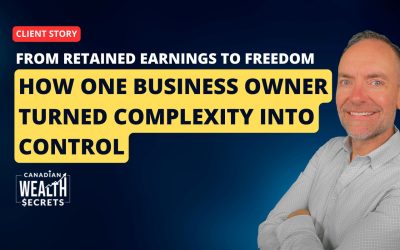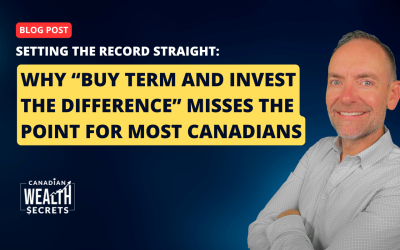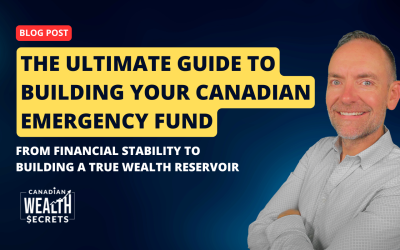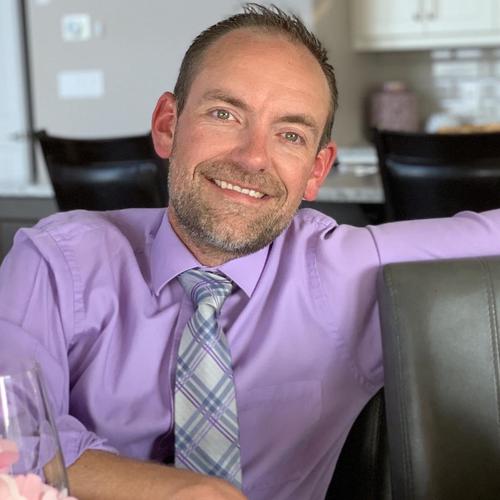When this Ontario-based chiropractor reached out to us in early 2024, he had a clear long-term vision: eventually purchase the commercial building his clinic operated out of. But he didn’t want to make the mistake of tying up all his corporate cash or missing other investment opportunities along the way.
Like many business owners, he had been diligently saving retained earnings inside his corporation. At the time, those dollars were parked in GICs—safe, but highly inefficient once you factor in passive income tax here in Canada. He knew there had to be a better way to position his capital while still keeping flexibility for the future building purchase.
Step 1: Establishing the Corporate Wealth Reservoir
Our first step together was clarifying his vision and designing a structure to support it. That’s what we call Stage 1 and Stage 2 in our four-stage wealth planning system:
- Vision & Direction – Defining the long-term personal and corporate financial goals.
- Establishing a Corporate Wealth Reservoir – Creating a tax-efficient pool of capital that grows over time and remains accessible.
To build this reservoir, we implemented a corporately owned whole life insurance policy—a powerful yet often misunderstood financial tool.
Why Whole Life Insurance?
Most people think of life insurance only as a way to protect loved ones in the event of death. But when properly structured—particularly inside a corporation—a participating whole life policy becomes much more than that.
In this chiropractor’s case, we used the policy as a strategic vehicle to:
- Move retained earnings out of passive investment accounts (like GICs) where they were heavily taxed.
- Grow those funds in a tax-sheltered environment through the policy’s cash value.
- Guarantee access to liquidity at any time through policy loans—without triggering personal income tax or dividend tax.
- Establish an opportunity fund that could be used to invest in future wealth-building assets (like the clinic building) without selling other investments or applying for traditional financing.
Why It Works So Well Inside a Corporation
Inside a Canadian-controlled private corporation (CCPC), passive income is taxed at the highest corporate tax rate—sometimes over 50%. This erodes long-term growth and reduces the flexibility business owners need when opportunities arise.
A corporately owned whole life policy solves this problem by:
- Removing passive income from the tax radar—investment growth inside the policy is not taxed annually.
- Creating tax-free liquidity through policy loans, which are not considered income.
- Maintaining control—the business owns the policy and can access its value on its own terms.
In this case, we even backdated the policy to the prior fiscal year—allowing the business to fund two years of premiums up front and immediately “supercharge” the policy’s growth. This strategy boosted the available cash value faster, setting the stage for what was originally thought to be a long-term play: purchasing the building his clinic operated in.
By the end of 2024, he had a properly structured corporate asset that quietly compounded in the background—ready to be used, tax-efficiently and flexibly, when the time was right.
The Surprise Acceleration: Timeline Moves Up
When we originally structured the plan, the expectation was that a building purchase wouldn’t happen for several years. There were issues with property severance, zoning, and coordination with the landlord.
Fast forward to spring 2025—just six months later—and the landlord was ready to move forward. Suddenly, the chiropractor found himself in a position to buy the building much sooner than anticipated.
Because he had proactively structured his policy a year earlier, his corporate wealth reservoir was already in a strong position. With two years of premium payments (thanks to the backdating), the policy’s cash value had grown quickly—almost enough to cover the full purchase price of $750,000.
By the time he made his third premium payment in late 2025, the cash value would be more than sufficient to buy the property outright using a policy loan.
But was that the best move?
Full Ownership vs. Strategic Liquidity: The Real Estate Dilemma
He now had a choice:
- Use a policy loan to buy the building outright, maintaining no mortgage or lien on the property.
- Or, take a more strategic route—leverage a third-party mortgage to fund most of the purchase and keep a large portion of the policy’s cash value liquid.
The challenge with going “all in” using the policy loan? You deplete your reservoir.
Sure, you now own a building. But what happens when the furnace breaks? Or revenue dips? Or an investment opportunity comes along?
A dry reservoir means lost flexibility.
We advised instead to consider a typical 70% loan-to-value mortgage and use a policy loan only for the down payment and closing costs. That way, he could still access capital through his policy in the future—whether for emergencies, reinvestments, or even high-return opportunities like stock market corrections.
Why Structure Matters
This setup also allowed for tax-efficient structuring between his operating company (the clinic) and the new holding company (which would own the real estate).
- The clinic pays rent to the holding company.
- The holding company covers the mortgage, taxes, and insurance—but doesn’t aim to generate excess passive income, which would be taxed heavily.
- The policy’s interest is easy to track and fully deductible since it’s tied directly to an income-generating investment (the building).
This keeps more capital working inside the corporation, reduces tax drag, and positions him for continued growth.
The Bigger Picture: Staying Nimble
This story is more than just a real estate win. It highlights the power of:
- Proactive planning
- Smart structuring
- Keeping access to liquidity
In another example we shared recently, a different business owner used a policy loan to buy into the market during a 20% drop—netting a quick 22% return. The point isn’t to time the market; it’s to have the flexibility to act when opportunities arise.
Final Thoughts: Your Wealth Plan Isn’t One-and-Done
This chiropractor’s journey shows the power of planning ahead—but also the importance of being nimble. Plans change. Timelines shift. New doors open unexpectedly.
That’s why a strong financial strategy isn’t a one-time event—it’s a continuous process of revisiting, optimizing, and adjusting.
And it’s why we created our Four-Stage Wealth Planning System—to help Canadian business owners like you build, grow, and protect your wealth with flexibility and confidence.
Want To See Where You Stand?
If you’re a business owner sitting on retained earnings or wondering how to build tax-efficient corporate wealth, let’s chat.
Book a free discovery call and we’ll assess where you are on your journey—then show you how to build your own corporate wealth reservoir and make smarter moves with your money.
Disclaimer: This content is for educational purposes only and does not constitute financial, legal, accounting or investment advice. Always consult with a qualified advisor before making investment, tax, accounting or legal decisions.






